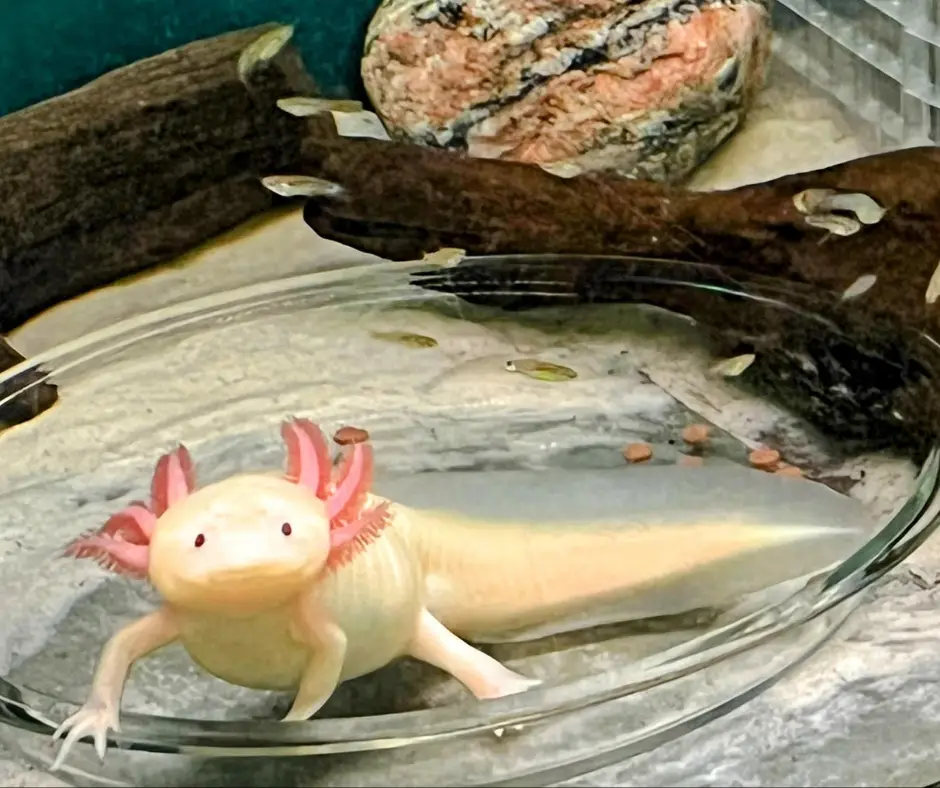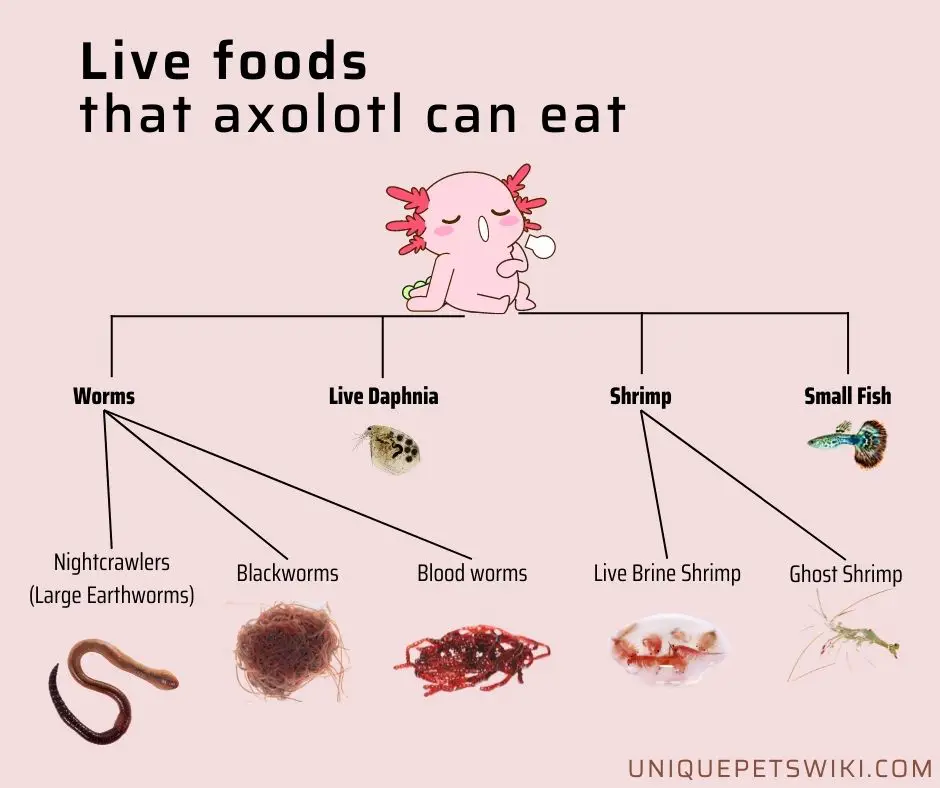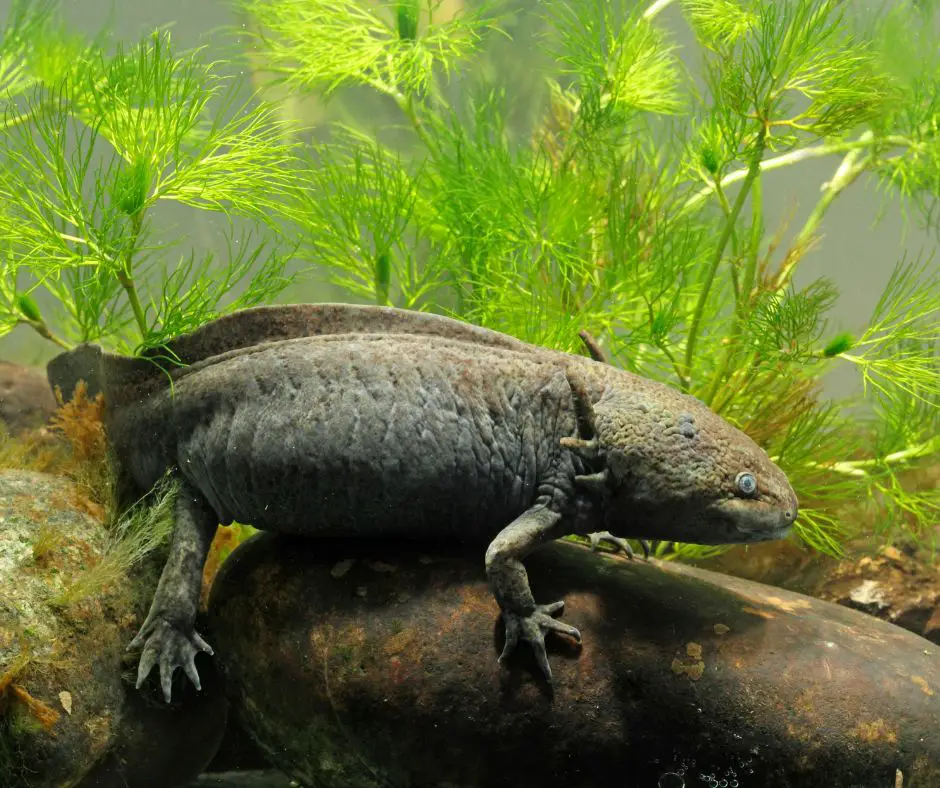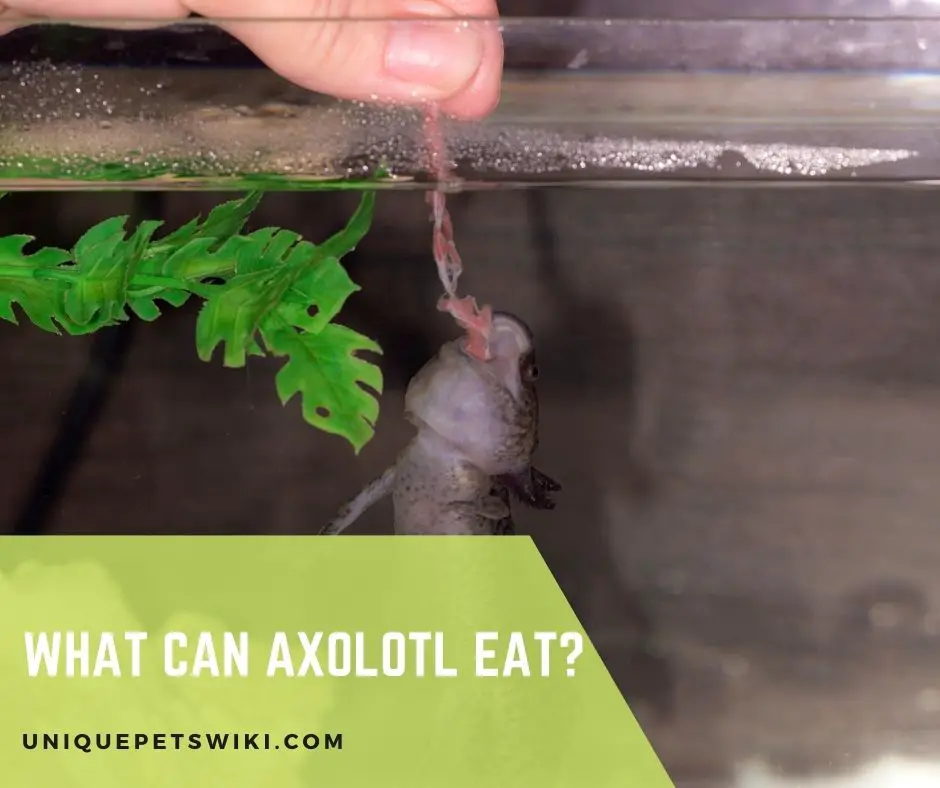Axolotls, also known as Mexican walking fish, are unique salamander species. Axolotls are opportunistic eaters and can eat anything that fits into their mouths.
As a responsible owner, you may wonder what the suitable food for your axolotls is to ensure they get the right nutrients.
Axolotls are carnivorous creatures, and their diet is centered mostly on meat. In the wild, axolotls eat worms, insects, and small fishes. You can feed your axolotls in captivity with live food, frozen foods, or pellets.
Getting the right nutrients for your axolotl is the main goal of good pet owners. Therefore, we came up with this article to help highlight everything you need to know about the axolotl diet.
Contents
What Can Axolotl Eat? (Baby to Adult Size)
Generally, axolotls feed on almost everything that can fit inside their mouth. In the wild, axolotls feed on small animals available in their environment. They can eat insects, slugs, worms, crickets, smaller salamanders, small crustaceans, mosquito larvae, frog tadpoles, etc.
Axolotls in the lab are usually fed with salmon pellets and brine shrimp. Axolotls kept as pets are usually fed foods like nightcrawlers, live daphnia, black/white worms, freeze-dried or frozen foods, bloodworms, small strips of beef or liver, salmon pellets, and other foods they eat in the wild.

Foods for Axolotl by Age
A newly hatched axolotls usually feed on their pouch for the first 48 hours. After that, you can start to feed baby axolotls with micro worms, brine shrimp, mosquito larvae, daphnia, some underwater bugs, algae, waste, and the remains of salmon and trout.
You can then feed adult axolotls with nightcrawlers, bloodworms, blackworms, daphnia, snails, insects, prawns, crustaceans, pellets, raw meat, and small freshwater fish, such as white cloud minnows, guppies, etc.
Live Food
Live food is regarded as the best nutritional food you can give your axolotls. There are several live foods suitable for axolotls, and some of them are worms, shrimp, live daphnia, small fish, etc.

Worms
Worms are an ideal staple food for axolotls as they are rich in nutrients that your axolotls need to grow. Therefore, they are a suitable food choice for axolotls. Some of the popular worms to feed your axolotls are stated below.
Nightcrawlers (Large Earthworms)
Nightcrawlers are considered the most convenient and ideal food choice for axolotls. They are highly nutritious, and you can easily get them wherever you are. Many owners will even tell you that axolotls love eating nightcrawlers the most.
The common nightcrawlers to feed your axolotls are European nightcrawlers, Canadian nightcrawlers, and red wigglers. The European and Canadian nightcrawlers have a high nutritional value than red wigglers.
However, red wiggler worms are more common because they are smaller and easy to breed.
| Pros | Cons |
– Very affordable – Healthy and nutritious – Easily accessible – An ideal diet for adult axolotls | – Not suitable for baby axolotls – Red wigglers excrete a stinky substance that most axolotls hate. – You need to clean them thoroughly before feeding your axolotls. |
Blackworms
Blackworms are an ideal substitute for nightcrawlers if you have a younger axolotl. Blackworms are a great source of protein for axolotls, and you can find them everywhere. However, blackworms can create a real mess in your axolotl aquarium, and you need to remove leftover blackworms immediately.
| Pros | Cons |
| – Suitable for younger axolotls. – Cheap and nutritious – Available everywhere | – Can turn your axolotl tank into a mess – Requires thorough cleaning. |
Blood worms
Bloodworms are another popular food choice for axolotls. You can feed bloodworms as either larvae of flies or marine worms. You can buy bloodworms either in live form or as frozen cubes.
However, bloodworms are not very healthy for axolotls like other worm varieties. You should only feed bloodworms to adult and juvenile axolotls as an occasional treat or coupled with other foods. Furthermore, bloodworms can create many messes in your axolotl tank and pollute the water.
| Pros | Cons |
| – Ideal for baby axolotl – It is cheap – You can preserve it by freezing it. | – Can turn axolotl water foul and smelly – Requires thorough cleaning – Can develop fungus very quick |
Should read: axolotl eating worms
Live Daphnia
Live daphnia are small crustaceans that you can use as a treat for your axolotls in the larval stage. Daphnia will help supply your baby axolotl with fatty acids, lipids, and other essential vitamins needed for their growth.
Furthermore, you can also feed daphnia to adult axolotls. However, live daphnia may not provide adult axolotls with enough nutrients and will keep them hungry for more food. It is recommended that you feed your axolotl with daphnia that you culture at home or a reputable source.
This is because daphnia can carry diseases and parasites that may affect your axolotl health.
| Pros | Cons |
| – Suitable and nutritious diet for baby axolotls – Cheap source of protein – Can be easily cultured at home – High in fatty acids, vitamins, and lipids – It helps to clean unwanted bacteria from your axolotl tank | – Not suitable for adult axolotls – Wild daphnia can carry diseases and parasites that can affect your axolotl. |
Shrimp
Shrimps are another popular alternative for feeding your axolotl. Some of the ideal shrimp for feeding axolotls are live brine shrimp and ghost shrimps.
Live Brine Shrimp
Brine shrimps are an ideal food alternative for feeding your baby axolotl in the absence of live daphnia. Brine shrimps are rich in vitamins, fatty acids, and lipids to help your axolotl grow healthy. A great way to offer brine shrimp to your baby axolotl is with Turkey baster.
However, brine shrimps also carry infections like live daphnia, and it is important that you breed them at home or buy them from reputable sources.
| Pros | Cons |
| – Great food source for baby axolotls – Very nutritious and cheap – Easy to make at home. – Easy to buy | – It can create lots of mess – It dies quickly in water and can carry diseases – Can change water hardness as it contains salt |
Ghost Shrimp
Ghost shrimps are a great food source for both baby and adult axolotls. Ghost shrimps have soft and smooth shells and do not pose any danger to axolotls. Ghost shrimps are not only healthy and nourishing, but they also help in maintaining your axolotl tank’s ecosystem.
Ghost shrimps help in tank cleaning as they feed on leftover food. However, ghost shrimps are rare and can be quite expensive to buy.
| Pros | Cons |
| – Helps in cleaning axolotl’s tank – Can be easily cultured – Highly nutritious – Suitable for both adult and juvenile axolotl. | – Should not be used as a whole meal for axolotl – Expensive – You will need to quarantine them for at least two weeks before feeding them to your axolotl. – Hard to breed them in freshwater. |
Small Fish
You can also feed your axolotls with small fish. Feeding axolotls with fish is ideal for adult axolotls as fish can cause impaction in baby fish. Some fish that you can feed your axolotls are guppies, goldfish, mollies, danios, or smaller and slow-moving fish.
Fish can help provide your axolotl with protein but should only be given to your axolotl as a treat. It is also best to keep feeder fish in a separate tank for about 14 days before feeding them to axolotls.
| Pros | Cons |
| – Highly nutritious – It helps add variety to axolotl’s diet – It helps to improve your axolotl hunting skills | – Can cause internal damage to your axolotl body – Axolotl can get impacted – Some feeder fish can carry bacterial and fungi fatal to axolotl’s health – Some fish can secrete toxins |
Frozen Food
Frozen foods are an excellent alternative for axolotls if live food is unavailable. Frozen foods can easily be sourced from local pet stores and are usually at a reasonable price. Some of the best-frozen foods suitable for axolotls are stated below.
Frozen Bloodworms
Frozen bloodworms are a popular food choice for baby axolotls, and most adult axolotls tend to enjoy it. Frozen bloodworms are rich in vitamins and proteins to help your baby’s axolotl grows healthy. However, it lacks all the nutrients that adult axolotls need to stay healthy.
They are usually in two different forms: frozen cubes or frozen sheets. You can buy bloodworms from local pet stores or online at a low price. However, you will need to ensure bloodworms don’t get stuck in your axolotl’s gill when feeding, as it can be quite fatal.
| Pros | Cons |
| – Axolotls enjoy eating them – Great source of protein and vitamins – Easily available and cheap | – It is messy and can disturb your tank chemistry – They can leave microscopic organisms that get stuck in axolotl’s gills if not cleaned properly. |
Frozen Brine Shrimp
Frozen brine shrimps are among the most available axolotl food out there. Frozen brine shrimps have great flavors and are rich in lipids, fatty acids, and vitamins. Adult axolotls love frozen brine cubes, and you can thaw it in water for a bit before feeding your axies.
You can then use a Turkey Baster to help ensure your axolotls get to eat them. You can buy frozen brine shrimp online or from your local pet stores. Another great thing is that you can hatch and culture brine shrimps at home.
| Pros | Cons |
| – Excellent food choice for axolotls Rich in fatty acids, lipids, and vitamins – Very affordable – You can keep it frozen for a few days | – Can make axolotl tank messy – Requires thorough cleaning of the axolotl tank. |
Pellets
The easiest food choice that you can feed your axolotls is the pellets. There is a wide range of pellets available for axolotls. However, many axolotls are used to eating worms and don’t really like eating pellets.
Furthermore, pellets are not 100% natural and may contain some fillers and chemicals. When buying a pellet for the axolotl, it is recommended to opt for those with at least 40% protein content and low fat.
There are two types of pellets that you can use for feeding axolotls, namely, sinking and smaller pellets.
Sinking Pellets
Slow sinking pellets are suitable pellets for larger axolotls. Axolotls usually prefer to sit and hide at the bottom of their tanks and love if their food can get to their hideaways. Therefore, it is great to feed your axolotls with sinking pellets that will sink to the tank bottom.
Smaller Pellets
Smaller pellets are more suitable for younger axolotls that cannot feed on regular sinking pellets due to their small mouths.
However, small pellets have a hard time sinking to the tank bottom where your axolotls like it. You can then use water to wet the small pellets that you want to feed your axolotls.
Then fill a Turkey Baster with the wet pellets to help ensure the pellet sinks to the tank bottom for juvenile axolotls to eat.
Check out our article: 4 Best Axolotl Food Pellets
| Pros | Cons |
| – Cheap food source for axolotls – Can be easily stored for some time – It is easily accessible – Easy to feed your axolotls | – It is not natural – You will need to clean leftover pellets to keep the water quality good. – Most pellets float, making it harder to feed your axolotls. |
Invert Aquatics Soft Pellets for Axolotls
- Quick Sinking
- Advanced Daily Nutrition
- Moist Sinking Pellets
- New Look! Same Great Food!
Last update on 2022-12-30 / Affiliate links / Images from Amazon Product Advertising API
How To Offer Food for Axolotl
Axolotl’s teeth are quite shallow, and it is not that sharp. Axolotls generally suck smaller creatures and swallow them whole instead of biting or tearing their food. This is why axolotls can choke on huge foods and can even give up after trying for a while.
This indicates that you need to be careful when offering your axolotls food. Here are some ways that you can offer your axolotls food.
For Live Food
Feeding axolotls with live food can be quite messy as they will be floating around in their tank. The best way to offer live food to axolotls is to use tweezers. Here are steps to follow when feeding your axolotls with tweezers:
- Use a tweezer to grab bite-size worms. It is also recommended that you cut bigger worms like nightcrawlers into 2 or 3 smaller bite-size pieces before you grab them with a tweezer.
- Lower the tweezer into the tank close to your axolotls
- Shake the worm to help catch your axolotl’s attention
- Wait for your axolotl to suck the food from the tweezer.
Note
- Avoid squeezing the food with your tweezers too tightly to help ensure your axolotl don’t have difficulty eating them.
- Ensure your live food is free from disease or parasite before feeding it to your axolotl.
- You can wash your live food thoroughly before feeding them to your axolotls.
- Live foods like ghost shrimps and feeder fish should be quarantined for about 30 days before feeding them to your axolotls as they can carry parasites.
Zoo Med Labs Angled Stainless Steel Feeding Tongs, 10″
- Stainless steel feeding tongs.
- Features an angled soft tip for safety.
- Designed to be more hygienic than hand-feeding.
- Makes it easy to feed your fella all his favorite foods.
- Perfect for your reptile, bird, turtle, aquarium fish and more.
Last update on 2022-12-29 / Affiliate links / Images from Amazon Product Advertising API
For Frozen Food
Feeding axolotls with frozen bloodworms or brine shrimp is quite simple but can also be messy. Therefore, you can use a plastic cup or plate with high sides to help prevent the food from moving around. Here are steps that you can follow when feeding axolotl with frozen food:
- Thaw the frozen bloodworms or brine shrimp in water for some minutes.
- Put a bunch of the bloodworms or brine shrimp in a cup
- Lower the cup into the water or use a turkey baster to offer the food to your axolotls.
- Wait for axolotls to go and grab their food in the cup.
- Remove the cup and use a turkey baster to clean up the leftover food floating around the tank.
Note: ensure the cup or plate is large enough for your axolotl to swim in and out without any issue.
Also read: How Much Bloodworms To Feed Axolotl?
OXO Good Grips Angled Turkey Baster with Cleaning Brush
- Tip is angled to easily get at hard-to-reach basting juices
- Flat foot keeps Baster from rolling and prevents drips
- Easy-to-read measurement markings feature standard and metric measurements
- Baster bulb and body made of high-heat safe materials and won't warp or crack
Last update on 2022-12-29 / Affiliate links / Images from Amazon Product Advertising API
For Pellets
It is quite easy to feed your axolotls with sinking pellets. You have to drop the pellets and clean up the leftover pellet with a turkey baster.
However, you will first need to soak floating pellets in a small cup of water before you feed your axolotls. You can then put the soaked pellets into a turkey baster and offer the pellets close to your axolotls. Then watch as your axolotls eat them and clean the leftover pellets.
How Often To Feed Axolotl?
You will be surprised to learn that axolotls do not require lots of food to stay healthy. You will need to feed baby axolotls daily as they are still developing and require enough nutrients to grow healthy.
You can feed them with 1-2 nightcrawlers per day or 2-3 pellets twice a day. However, you should ensure you cut the nightcrawlers into a few pieces before you feed your juvenile axolotls.
On the other hand, you can feed adult axolotls with 1-2 nightcrawlers or 2-3 pellets twice every other day. This will help to ensure you don’t overfeed your axolotl, as overfeeding can lead to constipation and impaction.
You can determine that your axolotl is well fed by checking their stomach. You can stop feeding your axolotl if you notice that their stomach has a similar size to their head. However, you should try to stop feeding your axolotl for the time being if their stomach is larger.
It is also important that you feed your axolotl with proper foods to ensure you don’t underfeed them.
How Long Can Axolotls Go Without Food?
Well-fed adult axolotls can go up to 3 weeks without eating any food. However, it is recommended not to let your axolotl go three weeks without feed.
It is best to feed your baby axolotl once a day to help ensure they grow healthy. You can then feed adult axolotls once every two days and follow the ‘Two-Minute Rule” to ensure you don’t overfeed your axolotls. A healthy axolotl’s abdomen is usually the same size as their head.

What Foods To Avoid Feeding Axolotl?
Axolotls are voracious eaters and can eat anything that you offer them. However, not all food types are healthy for your axolotls. Some foods you need to avoid when feeding your axolotls are stated below.
Big Size
As stated before, axolotls usually swallow their food instead of chewing on them. Therefore, you should avoid feeding them any food that is bigger than their head. This is because they will have a hard time swallowing it, and it can cause impaction.
Hard Exoskeleton
It is recommended that you avoid feeding your axolotls with food having hard exoskeletons like shellfish or crustaceans. Your axolotls will have a hard time digesting them fully, and it is possible for the axolotl to excrete it whole or cause impaction.
Don’t Feed Your Axolotl Processed Meats.
Processed meats are not good for axolotls, just like they are not good for humans.
This is because most processed foods have a high concentration of dangerous chemicals as they pass through processing plants, making them difficult for axolotls to digest. This can then have a negative impact on your axolotl health.
Some of the other foods to avoid are oily and fatty food and an herbivorous diet.
Can An Axolotl Choke on Food?
Generally, axolotls swallow their food whole and can easily choke on food. Therefore, your axolotl will probably choke on food if it is too big for them to swallow. This is because axolotls have shallow teeth and cannot use them to tear food.
This shows why it is recommended to feed your axolotl with smaller food. However, the food should not be too small as it can also get stuck in their gills, making it hard for them to breathe.
Conclusion
Axolotls are diverse eaters and do not select their foods like most pets. However, you will need to provide your axolotls with nutritious foods to keep them healthy and active. Some of the suitable foods to feed your axolotl are live foods, frozen foods, and pellets.
You must ensure you don’t overfeed your axolotl, as they can trick you into offering them more food. You also need to remove leftover food, whether you are feeding your axolotl with live foods, pellets, or frozen foods.



